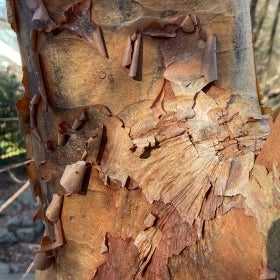What's in Bloom: January

January at the Morris

Lassie Koehne holly
Ilex x koehneana ‘Lassie’
Swan Pond
Boasting clusters of bright red berries, this broad-leafed evergreen tree is a cross between Ilex aquifolium (English holly) and Ilex latifolia (lusterleaf holly). Selected for its prolific fruit, the Lassie cultivar stands out in the garden this time of year.

spicebush
Lindera salicifolia
Long Fountain
After their vibrant display of fall color, the leaves of these spicebush shrubs turn a warm tan color and stay on through the winter.

Japanese stewartia
Stewartia pseudocamellia
Bark Park
Native to the mountainous regions of Korea and Japan, this small tree displays a patchwork of orange, tan, and gray bark as its outer layers shed off of the trunk. Japanese stewartias are in the tea family, Theaceae, and share similar flower characteristics to camellias as indicated in the species name which translates to “false camellia.”

lacebark pine
Pinus bungeana
Hill & Water Garden
Native to northwest China, this evergreen tree gets its common name from its flaking gray bark that exposes white, tan, and green layers of bark underneath. The lacebark pine at the Hill & Water Garden is original to the Morris Estate.

Blue Atlas cedar
Cedrus atlantica ‘Glauca’
Between Rose Garden and Pennock Garden
Blue-tinted needles create a spectacular display on this striking evergreen tree. Native to the Atlas Mountains in North Africa, Blue Atlas cedars are true cedars, which can be identified by their tight, whorled clusters of needles. The needles get their blue-green color from a waxy coating that helps the tree retain water.

Winter Gold common winterberry
Ilex verticillata ‘Winter Gold’
Sculpture Garden
This cultivar of our native deciduous holly is selected for its vibrant orange fruit that stay on significantly into the winter months. Ilex verticillata shrubs are dioecious, meaning the male and female reproductive parts are on separate plants. Only the female plants will fruit, and their berries are well-loved by birds this time of year.

paperbark maple
Acer griseum
Mercury Loggia
These trees provide year-round interest with striking tan and orange exfoliating bark. Many of the paperbark maple specimens in the garden today were wild-collected from China.